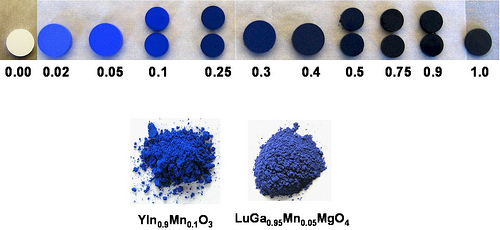An accidental discovery in a laboratory at Oregon State University apparently solved the question that engineers from ancient Egypt, the Chinese Han Dynasty, the Mayan culture and more have been dealing with for thousands of years - how to make a perfect blue pigment.

Throughout most of recorded human history, people around the world have searched for inorganic compounds that could be used to dye various objects blue, a task with limited success. Many of these compounds had stability limitations or environmental incompatibility. The cobalt blue pigment (Cobalt blue The entry in Wikipedia), developed in France at the beginning of the nineteenth century, may be carcinogenic. The pigment Prussian blue The entry in Wikipedia) may release the dangerous substance cyanide. Other blue pigments are unstable when exposed to heat or acidic conditions.
However, researchers from the University of Oregon discovered new compounds based on the metallic chemical element manganese that could overcome all these problems. These compounds are safer to produce, more stable, and may be much more environmentally friendly than any other blue pigment in use today or in the past. These compounds are resistant to extremely high temperatures and their color does not fade after a whole week in an acid solution.
The findings of the new research were published in the scientific journal Journal of the American Chemical Society and an application was submitted for a patent on the new compounds and the process for their production.
"Basically, it was a serendipitous discovery," says Mas Subramanian, professor of materials science in the Department of Chemistry at the University of Oregon. "We examined manganese oxides due to several interesting electronic properties inherent in them, mainly their ability to be both ferroelectric and ferromagnetic at the same time. Our research was not about finding pigment at all.
"Then one day, a student of mine working on our project took samples out of the hot oven while I was walking by, and they were blue, an amazing blue color," he explains. "I immediately understood that something amazing had happened here."
What happened, the researchers say, was that at a temperature of 1200 degrees Celsius, this manganese oxide, which under other conditions is particularly unexciting, turned blue and could be used to make a blue pigment that would be resistant to heat and acids, environmentally friendly and cheap to prepare.
And so the new blue pigment - and perhaps the best - in human history was born thanks to the placement of manganese ions in a rare arrangement of a triangular bi-pyramid when exposed to extreme heat.
"Ever since the ancient Egyptians developed some of the first blue pigments, the pigment industry has struggled with issues of safety, toxicity and stability," explains the lead researcher.
Eventually, the new pigment could be used in everything from inkjet printers to cars, fine arts and house painting, the researchers say.
The researchers claim in their paper that the new compound creates a "surprisingly bright and intense blue color," and describe its structure and properties in great detail.
"We have already encountered this during human history that many of the most interesting discoveries were not really born from detailed planning" notes the lead researcher. "There's luck involved, but I also teach my students that you have to be ready and willing to understand new things that are happening in front of your eyes, even if it's not exactly what you were looking for."

5 תגובות
Amazing. This color hardly exists in nature, try to name blue things that grow in nature.
This is also the reason why there is no blue food
Elijah:
The answer to your question at the beginning of the article.
Nice article
I'm not sure I got it right,
Until today was there a problem producing blue color?
Long live science!
A car in this color suits me